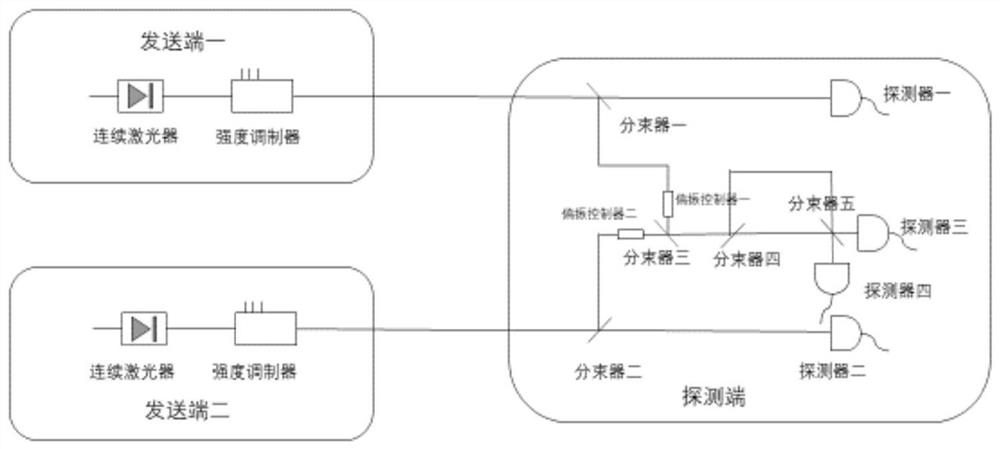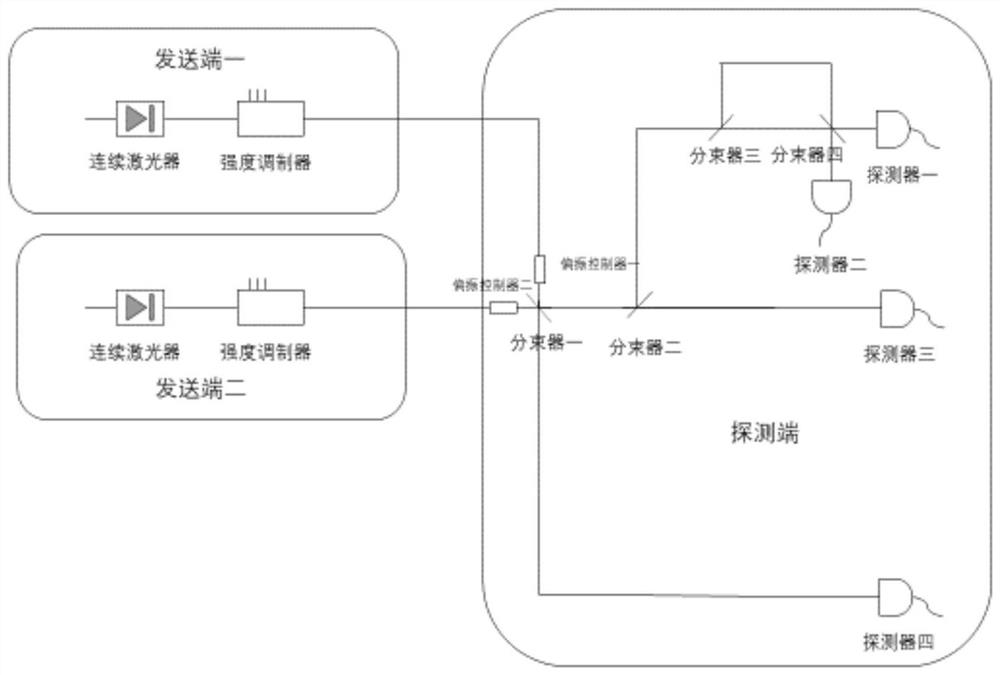Quantum conference key negotiation method and system based on coherent detection
A technology of key agreement and coherent detection, which is applied in the field of quantum communication, can solve the problems of increasing security risks and complex equipment, and achieve the effects of reducing security risks, simple equipment, and strong operability
- Summary
- Abstract
- Description
- Claims
- Application Information
AI Technical Summary
Problems solved by technology
Method used
Image
Examples
Embodiment 1
[0067] Such as figure 1 As shown, beam splitters are respectively set on the optical paths of the two transmitting ends to split the pulses of the two transmitting ends, one beam is sent to detector 1 and detector 2 for time base vector detection, and the other beam is polarized After the controller modulates the polarization, the pulse polarization of the two transmitting ends is consistent, and then sent to the beam splitter triple beam for interferometric vector detection; beam splitter 1 and beam splitter 2 correspond to sending end 1 and sending end 2 respectively; Polarization controller 1 corresponds to the pulse signal of the sending end 1, and polarization controller 2 corresponds to the pulse signal of the sending end 2; after beam splitter three combines beams, the Mach-Zehnder interference composed of beam splitter four and beam splitter five The pulse signal after interference is sent to detector three and detector four respectively for interferometric base vector...
Embodiment 2
[0091] The structure of the equipment in this embodiment has been greatly adjusted, but it is essentially the same as that of Embodiment 1.
[0092] combine figure 2 , to be specifically described: this embodiment includes two sending ends and a detecting end connected by an unsafe quantum channel; the sending end includes a continuous laser and an intensity modulator; the continuous laser is used to generate phase-stable continuous light; the intensity modulator will The temporally continuous optical signal becomes an optical pulse at a specific moment, and the amplitude of the pulse is modulated to form optical pulses of different intensities;
[0093] The detection end includes a polarization controller, a beam splitter and a detector; in this embodiment, a beam splitter 1 is provided on the optical path of the two sending ends, and the optical fiber distance from one of the sending ends to the beam splitter 1 is longer for The delay is an odd number of half cycles; a pol...
Embodiment 3
[0101] combine image 3 Introduce another way of combining beams - using fast optical switches.
[0102] Compared with the second embodiment, this embodiment is different from the present embodiment in that a fast optical switch is used for beam combining.
[0103] This embodiment includes two sending ends and a detection end connected by an unsafe quantum channel; the sending end includes a continuous laser and an intensity modulator; the continuous laser is used to generate phase-stable continuous light; the intensity modulator converts the continuous light in time The signal becomes a light pulse at a specific moment, and the amplitude of the pulse is modulated to form light pulses of different intensities;
[0104] The detection end includes a polarization controller, a fast optical switch, a beam splitter, and a detector; in this embodiment, a fast optical switch is set on the optical path of the two sending ends, and the optical fiber distance from one of the sending en...
PUM
 Login to View More
Login to View More Abstract
Description
Claims
Application Information
 Login to View More
Login to View More - R&D
- Intellectual Property
- Life Sciences
- Materials
- Tech Scout
- Unparalleled Data Quality
- Higher Quality Content
- 60% Fewer Hallucinations
Browse by: Latest US Patents, China's latest patents, Technical Efficacy Thesaurus, Application Domain, Technology Topic, Popular Technical Reports.
© 2025 PatSnap. All rights reserved.Legal|Privacy policy|Modern Slavery Act Transparency Statement|Sitemap|About US| Contact US: help@patsnap.com



